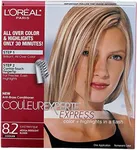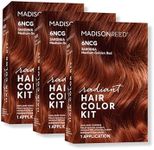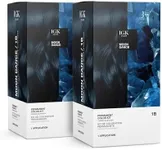Buying Guide for the Best Blonde Hair Dyes
Choosing the right blonde hair dye can be a transformative experience, but it requires careful consideration of several factors to ensure you achieve the desired look while maintaining the health of your hair. The key is to understand your hair type, the shade of blonde you want, and the formulation of the dye. Here are some important specifications to consider when selecting a blonde hair dye.ShadeThe shade of blonde is crucial because it determines the final look of your hair. Blonde shades range from platinum and ash blonde to golden and strawberry blonde. Lighter shades like platinum and ash blonde are more suitable for those with lighter natural hair or those looking for a dramatic change, while darker shades like golden and strawberry blonde can add warmth and are often easier to achieve for those with darker hair. Consider your skin tone and natural hair color when choosing a shade to ensure it complements your overall look.
Permanent vs. Semi-PermanentHair dyes come in permanent and semi-permanent formulations. Permanent dyes provide long-lasting color and are ideal if you want a significant change or need to cover gray hair. They penetrate the hair shaft and require less frequent touch-ups. Semi-permanent dyes, on the other hand, are less damaging and gradually fade over time, making them a good choice for those who want to experiment with color without a long-term commitment. If you're new to dyeing your hair or prefer less maintenance, a semi-permanent dye might be the best option.
Ammonia-FreeAmmonia is a common ingredient in hair dyes that helps open the hair cuticle to allow color to penetrate. However, it can be harsh and damaging, especially for those with sensitive scalps or damaged hair. Ammonia-free dyes are gentler and often contain conditioning agents to help protect and nourish the hair. If you have a sensitive scalp or want to minimize damage, look for ammonia-free options.
Developer StrengthThe developer is a crucial component of hair dye that activates the color. It comes in different strengths, typically measured in volumes (10, 20, 30, 40). Lower volumes (10-20) are less damaging and are suitable for subtle color changes or toning. Higher volumes (30-40) are more potent and can lift the hair color several levels, making them necessary for achieving lighter blonde shades. Choose a developer strength based on the level of lightening you need and the condition of your hair. If your hair is already light, a lower volume developer may suffice.
Conditioning IngredientsMany modern hair dyes include conditioning ingredients to help maintain hair health during the coloring process. These can include oils, proteins, and vitamins that nourish and protect the hair. Conditioning ingredients are especially important if you have dry or damaged hair, as they can help mitigate the drying effects of the dye. Look for dyes that advertise conditioning benefits to keep your hair looking and feeling healthy.
Allergy TestAn allergy test is a precautionary step to ensure you do not have an adverse reaction to the hair dye. This involves applying a small amount of the dye to a patch of skin and waiting 24-48 hours to see if any irritation occurs. This step is crucial for everyone, especially those with sensitive skin or a history of allergies. Always perform an allergy test before using a new hair dye to avoid potential reactions.






















